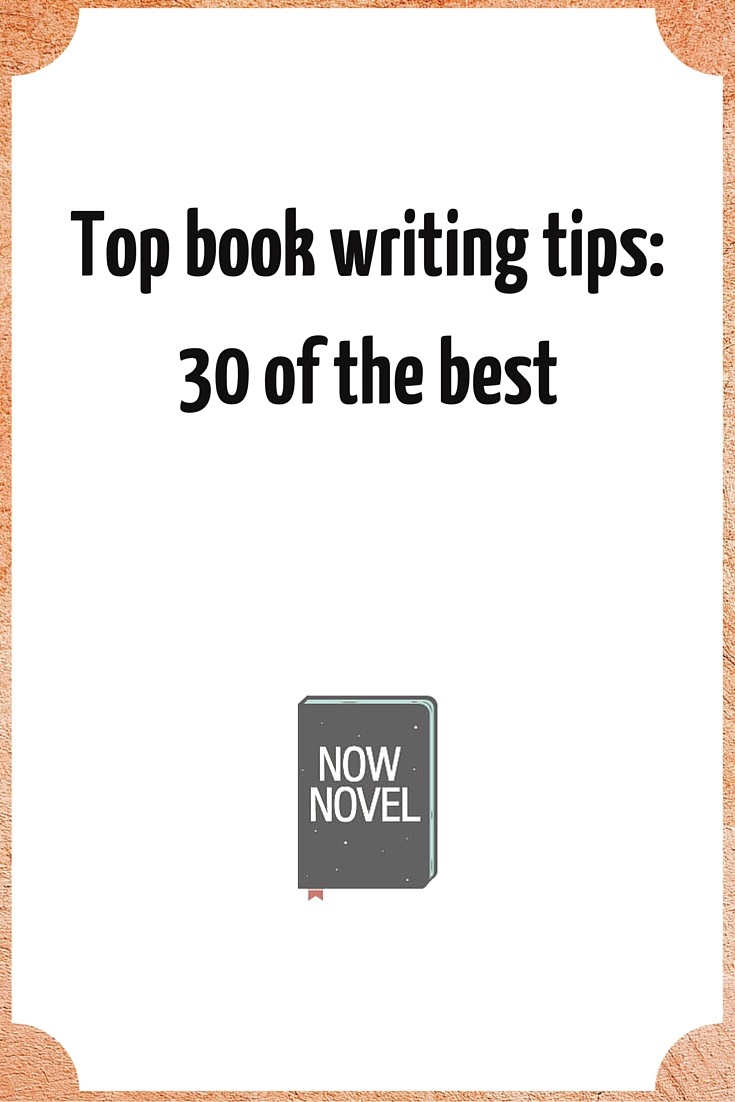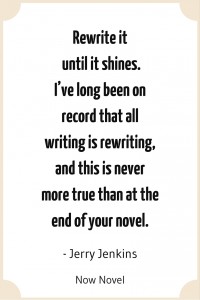Quotes on writing are a mixed bag. But the top book writing tips from the best writing blogs are actionable and practical. Here are 30 great pieces of advice from around the blogosphere:
5 tips on writing a helpful book outline
1. When writing a book outline, you have the opportunity to make each scene of your novel have purpose. K.M. Weiland of Helping Writers Become Authors offers this good advice on outlining individual scenes in a guest post for Writer’s Digest:
‘Focus on identifying and strengthening the key components of each scene’s structure. Who will be your narrating character? What is his goal? What obstacle will arise to obstruct that goal and create conflict?’
2. When you’re working from an outline, it’s important to be flexible and not be hamstrung by what you’ve put down so far. Creative Writing Now elaborates:
‘Don’t become a prisoner of your outline. I know one author who spent a whole year trying to get from Chapter 6 to Chapter 7 of her book because the outline said a certain event was supposed to happen. And she couldn’t find a way to make it work. In the end, she removed this event from her outline, and the problem was solved.’
3. Randy Ingermanson, creator of the snowflake outlining method, also reminds us to not be perfectionists about writing the perfect novel outline:
‘The purpose of each step in the design process is to advance you to the next step. Keep your forward momentum! You can always come back later and fix it when you understand the story better.’
4. Author and blogger Lynn Viehl provides advice for improving your novel outlining method:
‘Try outlining a novel you love by another writer. As with writing a synopsis, it’s usually easier to practice on someone else’s work, because the emotional attachment is different and probably not as intense.’
5. Even if you have a tight outline that gives you every step of your story to flesh out, let your characters’ voices be your guide when it comes to actually writing. YA author Lisa Nowak gives this advice on using your novel outline:
‘Your characters might tell you they don’t want to do something you have scheduled for them. Listen to them. Your subconscious is smarter than you are.’
Once you have an outline and are ready to write a novel, you can start drafting. There’s nothing to say you have to start writing your story from the beginning (you could write middle scenes first, if it suits you). Even so, a strong beginning is essential for grabbing readers’ interest:
5 top book writing tips for creating alluring beginnings
1. In a post for The Write Life featuring an extract from Writer’s Digest’s Guide to Literary Agents, there is this advice on avoiding novel opening mistakes from agent Rachelle Gardner:
‘One of the biggest problems is the ‘information dump’ in the first few pages, where the author is trying to tell us everything we supposedly need to know to understand the story. Getting to know characters in a story is like getting to know people in real life. You find out their personality and details of their life over time.’
2. Will Greenway reminds us that the opening of a story is where you have to win the reader’s confidence that you’ll be taking them on a worthwhile imaginative journey. He advises to establish the story’s tone and pace clearly:
‘Your opening scene sets the overall mood of your material, be it dark and gloomy, humorous, violent or whatever. This is where you play fair with the reader.’
3. When you start a story, hooking readers and making them want to continue can be achieved either by creating intriguing mystery or entertaining, satisyfing character introductions, as Janice Hardy says:
‘The best way to grab readers is to give them a puzzle they’ll want to know the answer to. An intriguing first line that poses a question (literal or metaphorical), an unusual situation, a mystery, a contradiction that doesn’t quite make sense. A great voice and character they want to get to know better is another way to hook readers.’
4. At Be Kind Rewrite, Stephanie Orges offers this simple but true advice on writing the first page of your story:
‘If you don’t emotionally engage your reader by page one, it’s over.’
It should be said that your first page doesn’t have to do this on first pass: during the first draft, give yourself licence to be boring. You can increase the intrigue, action and interest when you revise and make both the prose and action of your story more scintillating.
5. Chuck Wendig at Terrible Minds offers some choice book writing tips in ’25 things to know about writing the first chapter of your novel’:
‘Make a concerted effort to ask, “What is the mood I want the reader to feel throughout this book? What first taste hits their emotional palate?”’
5 tips for creating fantastic characters
There is endless advice on writing great characters on the web. The top book writing tips help us create characters who feel real. Here are 5 useful pieces of wisdom:
1. Sophie Novak, over at Joe Bunting’s The Write Practice, stresses the importance of understanding the inner workings of each of your characters’ minds:
‘To build great characters, you’ll need to understand people’s psychology: what are they thinking, what are they feeling and experiencing, why are they doing what they are doing?
‘Get behind the obvious. Be in the backstage with them. Sit them in a chair and let them talk away. Be their psychiatrist. If you truly listen, you will learn.’
2. Part of writing believable and intriguing characters is making sure that your characters’ psychology and personality are more or less consistent, unless intentionally altered by the course of plot events. Joanna Penn of The Creative Penn suggests to keep a record of character details, especially if you’re writing a series:
‘I keep a file readily accessible with all of my characters’ vital stats and what I’ve actually mentioned in each novel, so that I can maintain consistency throughout the series.’
3. Via Chuck Wendig again, a reminder that in addition to having individual, distinctive strengths and talents, great characters have flaws that make them more interesting and more believable:
‘Sherlock is an amazing detective, and a terrible human. Buffy’s a bonafide bad-ass, but she’s also a glib, impulsive teenage girl…Characters can be good at things but they can’t be too good — you need balance. If they’re the best at something, they should also be the worst at something. Conflict lives here; the space between Sherlock being the best detective and the worst human is so taut with tension the potential story might snap and take out someone’s eye.’
4. A large part of writing characters successfully is reflecting universal elements of what it means to be human. For example, everyone has fears, even if the content of these fears differs wildly. Via Melissa Donovan of Writing Forward:
‘An old fiction writing trick is to figure out what your character is most afraid of, and then make the character face it. We all have fears; characters should, too.’
5. Angela Ackerman of Writers Helping Writers offers plenty of advice on crafting believable characters with complex inner worlds. Characters who have complexity and nuance connect with us more emotionally, giving us the kind of emotional affect, wonder and surprise that other people are capable of giving us in real life. In this blog post, Ackerman stresses the importance of balancing the good and bad in a character’s life and backstory:
‘Just like every one of us, your character has a past. And while yes, backstory turmoil and pain should be exploited to create conflict and tension in the present, there is always good mixed with bad.’
In addition to credible characters, a great story has a sense of purpose and direction:
5 tips for crafting a winning plot
1. Creating a great plot means having a strong sense of cause and effect, of motivation and corresponding action, underpinning your story. The Writer’s Workshop has this to say about plotting:
‘The protagonist must have a clear central motivation. In literary fiction, that can be some fancy-schmancy motivation, like coming to terms with the death of a parent. In commercial fiction, it’s got to be a more obviously important goal – like getting married or saving the world. But it has to be clear. It has to be consistent. And it has to matter.’
2. Author Linn Ullmann, in an interview with Joe Fassler for The Atlantic, makes interesting suggestions about how plot and place should work in union to establish cause and effect and a sense of story:
‘The best writers provide a sense of events unfolding in this specific place, a place that informs and feeds the characters and events. What comes first: the place or the story? The story or the place? With great fiction, it can be impossible to distinguish.’
3. Amanda Patterson of Writers Write reminds us that plots that wrap up too tidily can be boring and forgettable:
‘The best endings in commercial and literary fiction, as well as memoirs, are when the protagonist achieves his story goal but…’
4. New York Times bestselling author Cassandra Clare defers to the wisdom of Aristotle in describing the ingredients of an effective plot:
‘PLOT is CHARACTER revealed by ACTION. No, I didn’t make that up; that’s Aristotle. Basically, plot isn’t something that exists outside the rest of your story – the characters, the action, the setting. Make up awesome characters. Put them in interesting situations. Force them to make important and revelatory choices that change them. Make sure that at the beginning of your story your characters want something.’
5. Janice Hardy shares this helpful advice on writing scenes that advance the plot versus scenes that just add decoration:
‘Every scene in your story is connected, and how you connect them will determine whether or not they’re moving the story or just showing stuff happening. If you can say “and then” between the scenes, they’re not advancing the story. If you can say “but” or “therefore” then something happens that forces a conflict or a decision and the story advances.’
Once you have a compelling story premise and cast of characters and a promising beginning, you need to follow through with a good read:
5 keys to writing great story middles
1. ‘Sagging middle syndrome’, in which a novel loses momentum, afflicts many books. Wendig, in his post ’25 ways to fight your story’s mushy middle’, gives this solution:
‘Scan your mushy middle and ask yourself: “Is it too one-note?” Are you focusing too much on one thing? One character? One conflict, theme, setting, something, anything? Mix it up. Make sure that all aspects of character and conflict are covered — physical, emotional, social, intellectual.’
2. Glen Strathy stresses the importance of increasing complications as your novel progresses (rather than inadvertantly removing or resolving sources of tension):
‘Sagging middles especially result when there is no increase in tension as the plot progresses. In the move towards the climax, your characters should face increasingly bigger obstacles and challenges. Things should get more complicated – never less.’
3. One way to keep the middle of your novel interesting is to introduce new characters, characters whose goals and motivations impact upon your primary character(s). As Martha Alderson puts it:
‘Develop secondary characters with goals at odds and in conflict with the protagonist’s goals.’
4. Fiction editor Beth Hill describes some of the dangers of story middles and how to make sure your middle is structured and as polished as the rest of your novel:
‘New characters—often too many—are introduced. Plot threads are added every chapter to bolster the narrative. Back story and info dumps find their ways in as well. Middles can be a mess. They get bloated or become unfocused. Plot elements ramble.
Characters grow verbose and contemplative rather than remaining active. Tension may seep out. Drama is reduced; conflict is only fleetingly visited. But middles don’t have to sag. Keep them fit and tight by separating the middle into its own sections—beginning, middle, and end.’
5. Chris Robley, writing for the Bookbaby blog, cautions us not to linger too long on individual plot points in the middle of a novel since this can weigh the story down:
‘If the structure of your story is predetermined, don’t linger on any one plot point longer than you need to. Tell it well and move along.’
Writing satisfying endings: 5 tips for tying it all together
While it’s your novel’s opening that makes the reader commit to your story, the ending is no less important. It’s what will determine whether a reader seeks out your follow-up novel or moves on to other reading pastures. Here is some good advice on endings from top book writing blogs:
1. Dancaster Creative offers good advice on keeping your novel’s ending in sight from earlier:
‘Think about when your “ending” begins. If it starts in the last two chapters, back up and rethink. The earlier your novel’s ending begins, the stronger and firmer paced the ending is. Most novel endings begin in the middle of the work and some in the first paragraph of Chapter One.’
2. Crista Rucker reminds that endings need to be the culminating effect of preceding cause:
‘The ending should come as the result of a choice that the main characters make. Every action and interaction, even down to every word of dialogue, whether your characters are talking about what to eat for breakfast or hashing out a plan to murder the villain, should foreshadow that final choice.’
3. NY Book Editors provides helpful advice on endings, including comments on the power of forward-looking endings:
‘End with a nod to the future. Often, as readers and writers, we want to know that everything is going to be okay for protagonists.
‘We want to end the story with some sort of sense of their futures. This can be tough as a writer, but it is possible to suggest a character’s future without over-simplifying.
‘Doing so through action helps avoid drifting into preachy narration, and often symbolism can help you say more than you’re actually saying in a final sentence.’
4. An ending can be unsatisfying if you’re too obvious about explaining your story’s themes and symbolism and its conclusion. As Writers Relief suggests, you can leave your novel’s ending open to interpretation by letting readers decide what the ultimate outcome (or the significance of the ultimate outcome) is:
‘Leave room for interpretation. Some great endings are open-ended. When you leave your ending open, you get people talking, thinking, and looking for answers.’
5. Rewriting is an important process for refining both the sense and the style of your story. As Jerry Jenkins says, it’s particularly important for writing a satisfying story ending:
‘Rewrite it until it shines. I’ve long been on record that all writing is rewriting, and this is never more true than at the end of your novel. When do you know it’s been rewritten enough? When you’ve gone from making it better to merely making it different.’
Always wanted to complete a novel? Finish writing a book with the help of a community of dedicated writers.




One reply on “30 top book writing tips from the best blogs”
These are good one.Today there are so much writings around and it is very hard to stand out against all the variety of content. On the other hand, many writers doesn`t mean good writers. Actually, if you will write really well, it wont be much a problem to stand out. The only difficulty is to come up with new interesting idea. But when you find it, everything will go much easier. Many are hardly looking for interesting conception and then leave writing to services like https://wedohomework.net/. Personally, I think that you should make everything from A to Z on your own, but it is only my opinion.